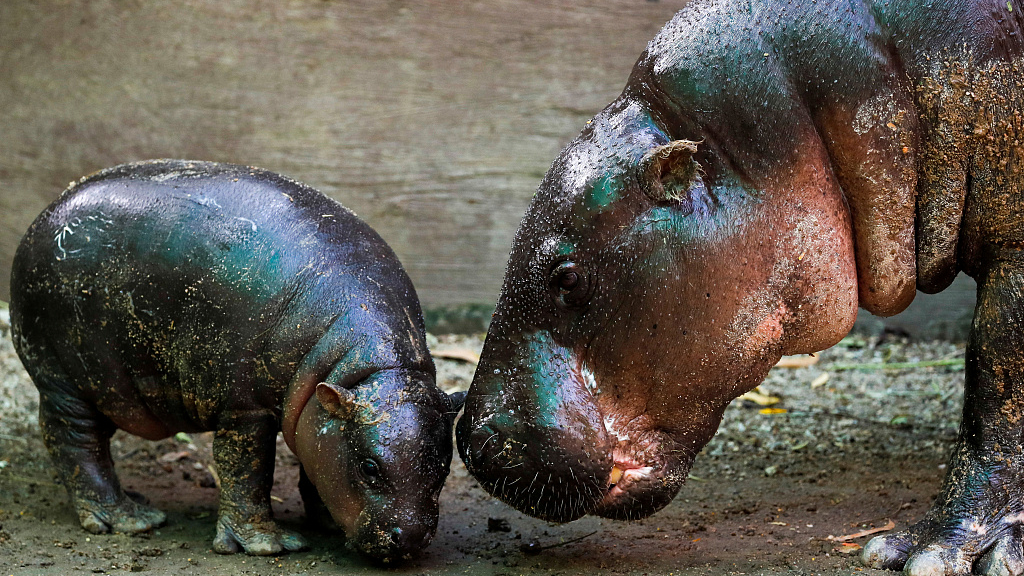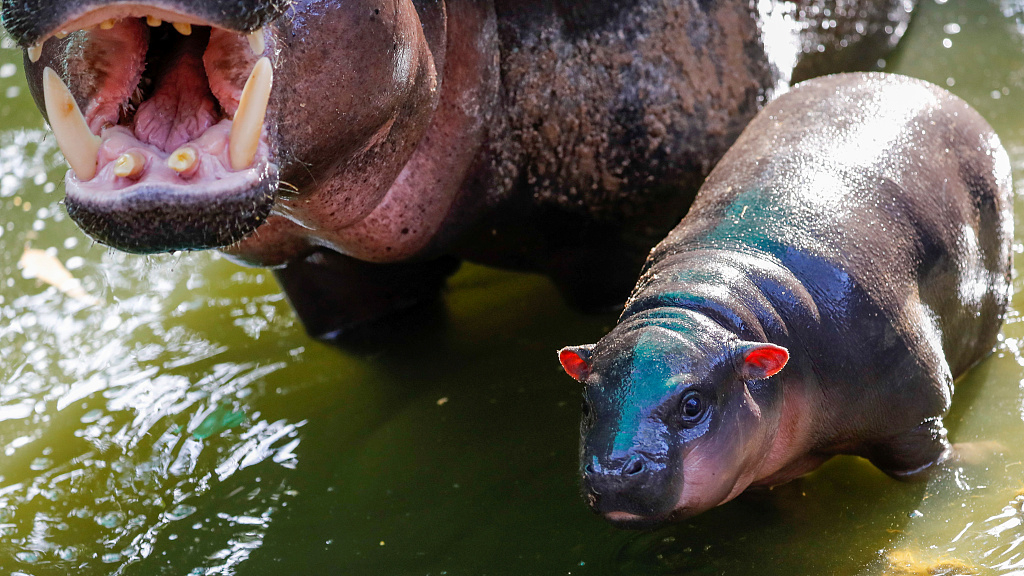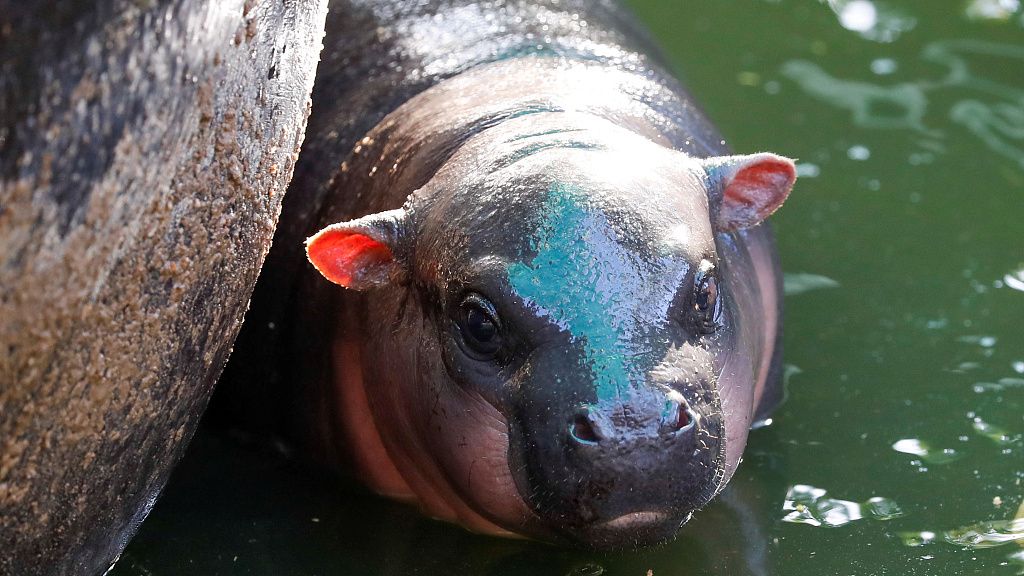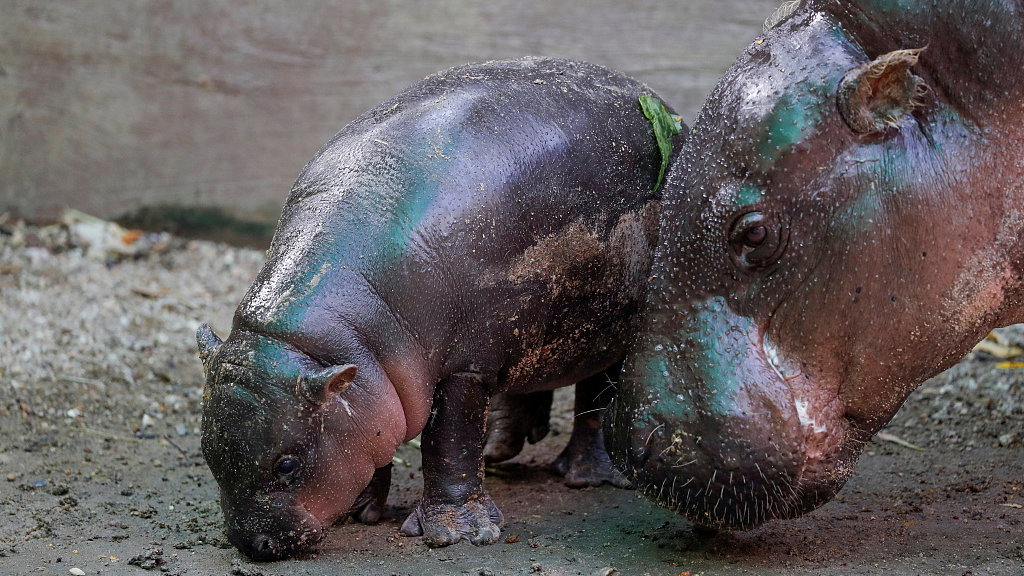Here is a piece of good news: A Thai zoo has welcomed the birth of a baby hippo. The healthy newborn happily explores the world with its mother.

A month-old baby pygmy hippo is seen with his mother at his enclosure at Khao Kheow Zoo in Chonburi, Thailand, November 30, 2019. /VCG Photo
A month-old baby pygmy hippo is seen with his mother at his enclosure at Khao Kheow Zoo in Chonburi, Thailand, November 30, 2019. /VCG Photo

A month-old baby pygmy hippo is seen with his mother at his enclosure at Khao Kheow Zoo in Chonburi, Thailand, November 30, 2019. /VCG Photo
A month-old baby pygmy hippo is seen with his mother at his enclosure at Khao Kheow Zoo in Chonburi, Thailand, November 30, 2019. /VCG Photo

A month-old baby pygmy hippo is seen with his mother at his enclosure at Khao Kheow Zoo in Chonburi, Thailand, November 30, 2019. /VCG Photo
A month-old baby pygmy hippo is seen with his mother at his enclosure at Khao Kheow Zoo in Chonburi, Thailand, November 30, 2019. /VCG Photo

A month-old baby pygmy hippo is seen with his mother at his enclosure at Khao Kheow Zoo in Chonburi, Thailand, November 30, 2019. /VCG Photo
A month-old baby pygmy hippo is seen with his mother at his enclosure at Khao Kheow Zoo in Chonburi, Thailand, November 30, 2019. /VCG Photo

A month-old baby pygmy hippo is seen with his mother at his enclosure at Khao Kheow Zoo in Chonburi, Thailand, November 30, 2019. /VCG Photo
A month-old baby pygmy hippo is seen with his mother at his enclosure at Khao Kheow Zoo in Chonburi, Thailand, November 30, 2019. /VCG Photo
So, what do you know about the giant beasts? These facts may be new to you:
Hippos are mostly herbivores, but they have been filmed eating carrion, usually close to the water. There are also other reports of meat-eating, even a hippo eating another hippo's dead body.
2, The hippo is one of the most dangerous animals in Africa.
The hippo is among the most dangerous animals in the world as it is highly aggressive and unpredictable. Adult males are fiercely territorial, they are not afraid of attacking other animals, even humans in boats, to protect their territories and wives. Small boats can be capsized by hippos and passengers can be injured or killed. In one 2014 case in Niger, a boat was capsized by a hippo and 13 people died.
3, You may not be able to outrun a hippo.
Despite its stocky shape and short legs, it is capable of running 30 kilometers an hour over short distances. Comparatively, a normal person can sprint an 32 kilometers per hour.
4, Hippos have a stronger bite than big cats.
The bite of an adult hippo has been measured as 8,100 newtons, or 2000 psi. Even the biting champion in the feline family, the jaguar, can only reach 1500 psi, while a lion can only do 650 psi.
5, When you see a hippo "yawning," run!
A hippo can open its mouth to almost 180 degree without tearing any muscles apart. When you see a hippo opening wide its mouth like it is "yawning", it's not a sign of fatigue, but a threat showing that it's angry and ready to attack.
6, Hippos are not very good at swimming.
Contrary to many people's impression, the semi-aquatic animal does not excel at swimming. If you have seen a hippo in water, it "walks" than "swims." It can also neither float on water, nor hold its breath for long underwater. They have to come up to the surface for air every few minutes. A hippo sleeping underwater can rise and breathe without waking up.
7, Hippos are close kin of whales.
The closest living relatives of hippos are whales, dolphins and porpoises.
8, They are the third largest land mammals.
There are only two species of hippos: The common hippo and the pigmy hippo, both endemic to Africa. The common hippo is the third largest land mammal, coming after the elephant and the white rhino.
Despite their bulky and heavy appearance, hippos' subcutaneous fat layers are quite thin. The 2,000-kilogram giant is mostly made up of muscles, and 6-centimeter thick skin.
10, The "blood sweat" is a natural sunscreen.
The hippo's skin can secrete an oily red substance that is neither blood nor sweat, but a natural sunscreen which also inhibits the growth of disease-causing bacteria. However, this natural sunscreen cannot prevent the animal's skin from cracking if it stays out of water for too long.
Everybody knows what a hippo looks like. This gives us the illusion that the animal is very common. In fact, the hippo is classified a vulnerable species by IUCN, while the pygmy hippo is evaluated as "endangered" with a decreasing population of merely 2,000 individuals.
Hippos' fangs can be as long as 40 centimeters, which is a fearsome weapon in battles. Poachers use hippo fangs as substitute of ivory. Besides, the hippo meat is considered a delicacy in some areas. While habitat loss also puts the species in danger.
Hippos aren't the first creatures that come to mind when we think of vulnerable or endangered animals, but they do desperately need our support.
(All pictures via VCG. Cover photo via VCG, designed by CGTN's Li Wenyi. Edited by An Qi)
(If you want to contribute and have specific expertise, please contact us at nature@cgtn.com)